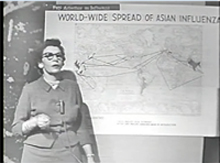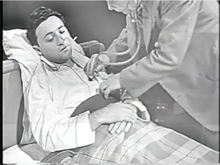
Dr. Charlotte Silverman charts the spread of the 1957 Asian flu. (Johns Hopkins File 7)
In 1957, the Ford Motor Co. rolled out its infamous Edsel sedan; the world was in the midst of an escalating Cold War; the Soviet Union launched the first man-made satellite, Sputnik, into orbit; and President Eisenhower sent troops to Arkansas to protect African-American students while a Little Rock high school was being integrated.
In 1957, the world was also in the grip of a deadly influenza pandemic, known as the Asian flu. Although less severe than the 1918 Spanish flu that killed an estimated 50 million people, the 1957 Asian flu was ultimately responsible for 70,000 deaths in the United States and nearly 2 million deaths worldwide over the next year.
Today, as the potential looms for another global pandemic from H5N1 influenza (bird flu), a 1957 episode of the Johns Hopkins File 7 television program offers a unique glimpse into the past. The episode “Asian Flu,” which first aired on ABC Television on November 2, 1957, serves as a virtual time capsule with its firsthand perspective of that pandemic.

Actor demonstrates the symptoms of Asian flu. (Johns Hopkins File 7)
In the program, host Lynn Poole and renowned epidemiologist Dr. Charlotte Silverman trace the origins and spread of the Asian flu (H2N2), as well as recount the first discovery of the influenza virus in 1933. Silverman, who was then chief of the Division of Epidemiology and Communicable Diseases for the Maryland Department of Health and a graduate of the School of Public Health, tells viewers how to avoid contracting the flu (or grippe as it was called back then) as actors demonstrate the symptoms of illness. Animated cartoons of viruses and antibodies illustrate how vaccines work. At one point, Silverman carefully explains that antibiotics, which she calls “the new miracle or wonder drugs,” could not be used to treat influenza, or any virus.
Johns Hopkins File 7 is part of the collection of the Sheridan Libraries of the Johns Hopkins University. From 1948 to 1960, the University produced more than 700 educational television films, which were broadcast under the titles The Johns Hopkins Science Review, Tomorrow, Tomorrow’s Careers and Johns Hopkins File 7. The programs aired on the CBS, ABC and former DuMont television networks. According to the Sheridan Libraries, The Johns Hopkins Science Review was the first university-based television series to air on a national network and it was also the first to be broadcast overseas.—Tim Parsons